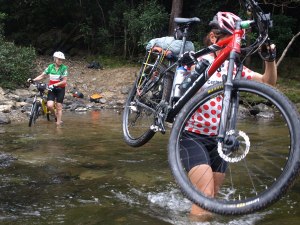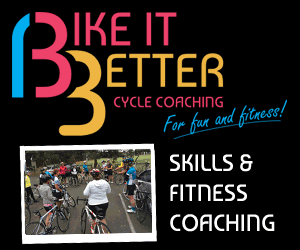What started out as a quest for an elusive fish has turned into an annual two-wheeled odyssey. Cycling author Bruce Ashley reports on a decade of reconnaissance of a largely unknown but close-by Pacific neighbour.

Being a bit of an outdoorsy person and a fishing tragic, an article in Aussie flyfishing mag extolling the virtues of New Caledonia for its bonefish* caught my eye. New Caledonia’s capital Noumea is a stop-off for cruise ships, but what of the rest of the island for cycling, fishing and general adventuring? I pored over as many maps that I could find, and satisfied that it was big enough and lumpy enough to stretch a cycle tourer’s legs and mettle, I prepared my hardtail Iron Horse to carry a 5-piece rod and sundry baggage. But despite all the research and with my bike boxed for air travel, in September 2002 I still had no idea what it would really be like.
The fun really started on the first outing 120km south to Ile des Pins (Isle of Pines). It is a two-hour ferry trip to get there but you’re treated to amazing resort-style beaches, traditional pirogue (catamaran) trips and kayaking over blue waters. Riding and relaxing was easy, but bonefishing not.
Back on the 450km-long main island, Grande Terre, I decided to head to the very northern tip to a place called Boat Pass. It was an exciting and energetic trek: up the drier and well-farmed west coast, then a hop over a mountain pass, followed by a 40km descent then cruise along a river valley to the first of many east-coast villages.
Riding the very much greener east coast was mostly on a sealed road hugging the palm-fringed coastline. As I rode, blown by a helpful tailwind, along past the small communes (communities), Kanaks tending their gardens would wave excitedly, call out, or clap in appreciation. It’s such a change to be greeted like this as you ride by! I would stop now again for a chat, buy fruit at a roadside stall or explore cascades off to the side.
The last 80km was on a remote dirt track. And after three weeks of cycling and camping the length of New Caledonia and smoothing the way with the traditional Kanak owners to allow fishing, I had my first fly-caught bonefish.
What I had learnt from this and later visits is that I love tailwinds! It’s best to go with the flow of the prevailing south-easterly trade winds that blow for four days out of five and carry you north along the coast. You can then avoid the return headwinds by using local buses with the bike slung under.

In December 2007 I experienced New Caledonia’s climate mid-summer when I decided to tour 300km of the south region in five days. Throw in 17kg of gear, a strong sun, tropical heat and a few hills and it starts to get tough. But it’s amazing how you can adapt: morning riding to avoid the afternoon back-radiation; stripping off and swimming in any number of crystal-clear streams and cascades; always riding with a river-soaked shirt; and using a few grams of water purifying tablets in the water bottle filled en route rather than carry many kilos of water on ascents. Highlights were spotting an elusive cagou (the country’s iconic bird) on a forest track, the magnificent waterfall Chute de la Madeleine, as well as finding a scenic valley-hugging hydro access road to avoid a 500m ascent then descent to the coast.
On each visit I have included a mix of the regular haunts and exploring new ways to ride over the main divide. For me the best routes are off the beaten track, avoid massive climbs and follow waterways and rivers. But they also pass an occasional snac or magasin for supplies and chance to practice my French. So in 2008 I discovered an alternate route that avoided a 500m climb. It was a riverside trail that appears to have been the old and forgotten horse and cart route along the east coast prior to mining access roads being bulldozed straight up and over the mountains. This was followed two days later riding from Ponerihouen on the east coast, up over the main range to camp on the 1000m peak Mt Aoupinie, then a 25km descent though fern forests and a flora reserve to the west coast. On some of the higher elevation trails above about 500 metres it can be like riding across the neighbour’s front lawn as these remote trails have almost no traffic and the grass sward is neatly clipped presumably by the feral Rusa deer.

All the while I am searching for that fabulous route and great riding experience. Some of these routes have been tested, while some sections needing regular checking to confirm that they are still rideable. A big rain event in June 2013 caused major damage to many trails, and landed a whole lot of silt on some of the river flats. Emboldened by previous trips, myself and three ride buddies Kerrie, Liz, and Ed went exploring the Chemin des Arabes, a 60km trail over the mountains from Hienghene to Voh. This is a route possibly never ridden en vélo before, and certainly not traversed by any vehicle in recent decades. The 23 river crossings certainly added to the sense of adventure.

So what are the best places to visit and best routes to use if you are planning a cycle tour to New Caledonia? High on the my list would be a tour starting at Bourail on the West coast, over the divide to Houailou then up along the east coast to Hienghene and return by bus or if you are adventurous, re-crossing the mountains on one of the less-used trails. A trip to the South area including Parc de la Riviere Bleue, Yate and Prony Bay (for whale watching in spring) is another great ride idea, as is putting the bikes on board a ferry bound for Ile des Pins or the Loyalty Islands. For shorter day tours, setting up a base in the La Foa area (about 100km north of the International airport at Tontouta) gives you a choice of riding up to see the giant fern forests at Farino, pedalling over to Sarramea to see former coffee plantations, or ride to the coast near Bourail, where there are artisan-crafted gite (cabins) at Nekweta, impressive coastal cliffs and rock formations and sailboarding at Poe Beach.
Seven flights across the Tasman and over 20 tours later, New Caledonia has given me a wealth of cycle touring delights, challenges and pleasures. The riding varies from motoring along the (right-hand) smooth shoulder of the highway heading out of Noumea, to pedal-meditating quiet rural arterial roads hugging the palm-fringed coastline or long, winding river flats, to the mountain routes like a crumpled track across a vast green carpet. There are also the cultural pleasures of the varied language, a mix of Kanak communities, and the tradition and food that make this place tropical and Kanak, but with a distinct French influence.
Bon route!
* Bonefish (Albula spp.) is a prized salt-water fly-fishing catch. The white sandy tidal flats of New Caledonia harbor world-class bonefish.
Need to know

Location New Caledonia is a French Territory, about 1,200km north east of Brisbane in the South Pacific. The Isle of Pines is 120km south east of Noumea. The Loyalty Islands are 180km north east of Noumea.
Getting there and around Air Calin and Qantas fly to Tontouta International airport daily. It is a two-hour flight from Brisbane or two-and-a-half hours from Sydney. Air Calin have also recently added direct flights from Melbourne, running on Tuesday and Friday. Tontouta airport is 40km north of Noumea. Bikes must be boxed, or alternatively you can take a fold-up bike. Air Caledonie is the internal carrier from Noumea’s Magenta Airport. There is a regular ferry service to Isle of Pines and Loyalty lslands.
Accommodation There is a range of hotels, homestays at local Kanak tribu/gites (cabins) and camping is available at campgrounds and possible en route with permission.
Language and culture There are 26 different indigenous Kanak communities in 8 major language groups. Most Kanaks and the ‘metros’ speak French, with limited English spoken in urban areas and tourist areas. For more general and travel info visit the official New Caledonia tourism website.
Cycling Riding is on the right-hand side of the road. Helmets are not compulsory. For bike hire, try Noumea Fun Ride (at the main passenger-ship terminal) and Sud Loisirs at Parc Riviere Bleue. There are a few cycle shops in Noumea but none elsewhere.
Transits You can put your bike onboard the long-distance coaches that depart Noumea, stopping on demand. Ferries to the Isle of Pines and Loyalty Islands take bikes for a small fee, while the internal air carrier takes them for a large fee (space permitting).
When to visit The middle months of the year are best, with August as the pick of the weather for touring. September and October are best for swimming and warmer nights for camping.
For more photos and organised tours to New Caledonia with Bruce see www.bike-it.com.au.
Ride On content is editorially independent, but is supported financially by members of Bicycle Network. If you enjoy our articles and want to support the future publication of high-quality content, please consider helping out by becoming a member.



The distinguishig feature of New Caledonia, vs. other Pafific neighbours, is that there is good investment in infrastructure – thus the roads are tarmac and the major ones don’t have many potholes, there are traffic lights, etc (not on mountain tracks, obviously). Mobile phones and devices work in pretty much all the populated areas too. But also, NC is expensive, since its currently is pegged to the Euro.
The article neglects to say that the landscape is quite scarred by decades of nickel mining in the upper hills and mountains – restoration of these landscapes is slow or non-existent. Nonetheless the scenery is spectacular and plants are 80% or so endemic.